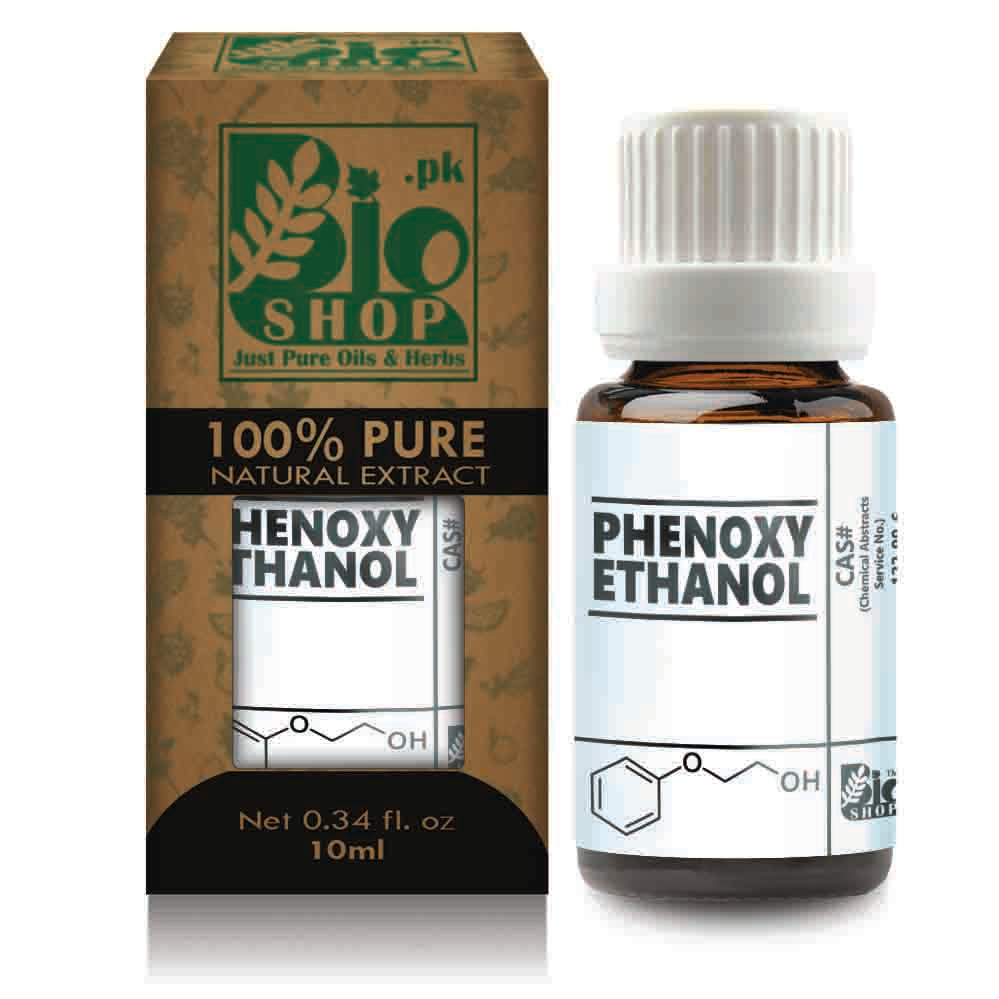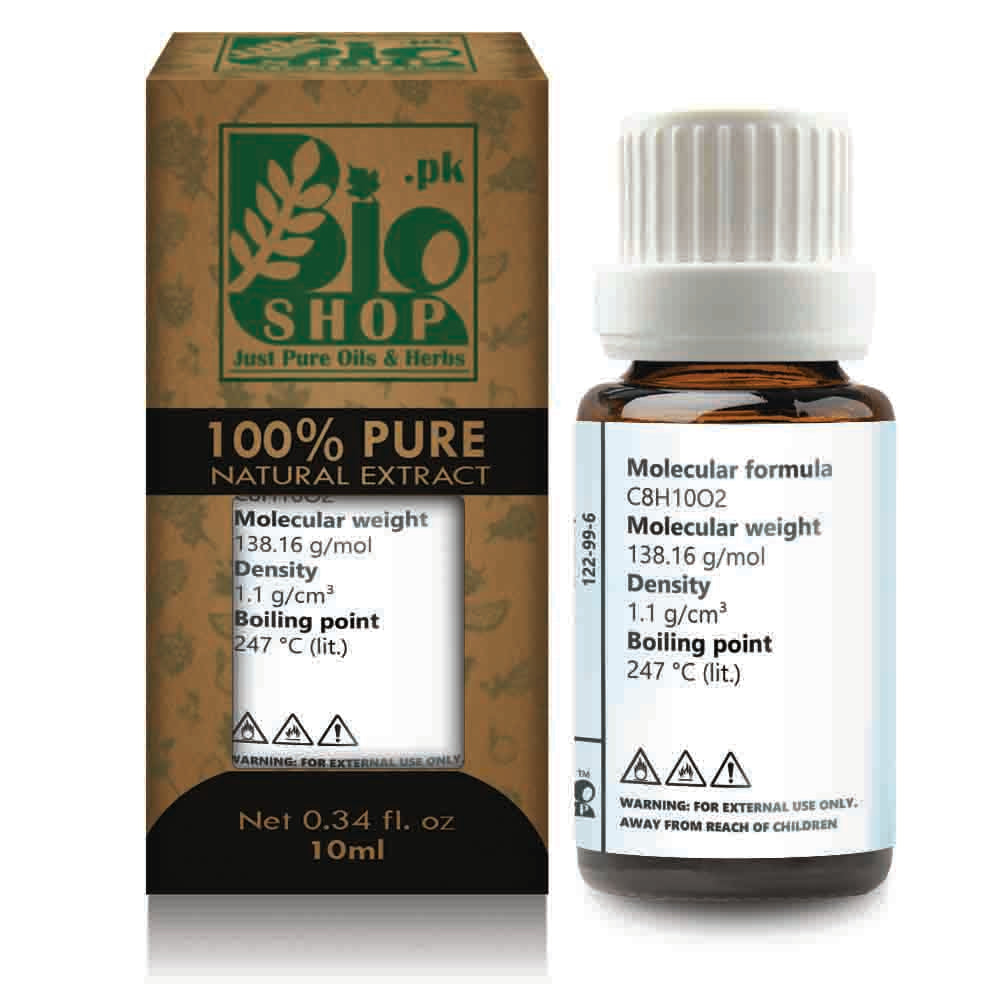Bio Shop
Phenoxyethanol
Phenoxyethanol
Key Functions: Acts as a broad-spectrum antimicrobial preservative in water-based cosmetic formulations.
Couldn't load pickup availability
Explore
Information About Phenoxyethanol
✅ Key Features
- Effective against gram-positive and gram-negative bacteria, yeast, and mold
- Compatible with a wide pH range (3–10)
- Works well with other preservatives like ethylhexylglycerin
- Paraben-free and globally approved for rinse-off and leave-on products
- Stable at high temperatures and in presence of light
🔬 Description
Phenoxyethanol – Broad-Spectrum Preservative for Modern Cosmetics
Phenoxyethanol is a widely used broad-spectrum preservative found in modern cosmetics, personal care, and pharmaceutical products. It is particularly valued for being formaldehyde-free, paraben-free, and effective at low concentrations (0.5%–1%). Phenoxyethanol provides protection against bacteria, yeast, and mold, making it ideal for emulsions, serums, and water-based systems. It is often combined with other preservatives (like ethylhexylglycerin) to boost performance in mild, low-irritation formulas. This ingredient is approved globally, including by the EU, FDA, and Japan.
📊 Technical Data
INCI Name: Phenoxyethanol
CAS Number: 122-99-6
Solubility: Slightly soluble in water; soluble in alcohols and glycols
Add Phase: Cool-down phase (<40°C)
pH Stability: 3.0 – 10.0
Processing Temperature: Add below 40°C
Appearance: Clear, colorless liquid
Odor: Mild, rose-like
Molecular Formula: C8H10O2
Molecular Weight: 138.17 g/mol
Flash Point: ~120°C
Density: ~1.10 g/cm³
Chemical Type: Glycol ether
Functional Groups: Hydroxyl, Ether
Primary Cosmetic Uses: Preservative in creams, serums, shampoos, baby products, makeup
🧪 Recommended Usage
- Usage Rate: 0.5% – 1%
- Phase: Cool-down (below 40°C)
- Ideal For: Creams, serums, shampoos, toners, cleansers
💡 Pro Tip
💧 Always add Phenoxyethanol during the cool-down phase (<40°C) to retain full preservative activity. Pair with Ethylhexylglycerin for enhanced broad-spectrum protection and lower irritation risk.
👩🔬 Skin Type Compatibility
✔️ Safe for most skin types when used at proper dosage
✔️ Commonly used in baby care and sensitive-skin formulas
❗ Avoid overuse above 1% to prevent irritation
🧴 Formulation Ideas
1. Paraben-Free Face Cream
Use 1% Phenoxyethanol as the sole preservative in oil-in-water emulsion to prevent microbial growth.
2. Hydrating Serum
Include in the cool-down phase to protect low-viscosity serums from contamination.
3. Natural Shampoo
Combine with ethylhexylglycerin for effective preservation without parabens or formaldehyde releasers.
4. Micellar Water
Preserve water-based formulations with 0.8% for clear, shelf-stable solutions.
5. Makeup Base or Primer
Ensure microbial safety in water-containing makeup products like primers and liquid foundations.
💧 Cosmetic Suitability:
Serums
⭐⭐⭐⭐⭐ – Excellent
🟩🟩🟩🟩🟩 – Preserves water-based serums effectively.
Creams & Lotions
⭐⭐⭐⭐⭐ – Excellent
🟩🟩🟩🟩🟩 – Ideal preservative for emulsions.
Toners
⭐⭐⭐⭐☆ – Good
🟩🟩🟩🟩⬜ – Keeps toners microbe-free without heaviness.
Face Masks
⭐⭐⭐⭐☆ – Good
🟩🟩🟩🟩⬜ – Especially in gel or cream masks.
Cleansers
⭐⭐⭐⭐☆ – Good
🟩🟩🟩🟩⬜ – Useful in low pH gel cleansers and micellar water.
Hair Masks
⭐⭐⭐⭐☆ – Good
🟩🟩🟩🟩⬜ – Maintains shelf life in moisture-rich hair products.
Deodorants
⭐⭐⭐☆☆ – Moderate
🟧🟧🟧⬜⬜ – Useful in gel or cream deodorants.
Eye Creams
⭐⭐⭐⭐☆ – Good
🟩🟩🟩🟩⬜ – Mild enough for sensitive areas.
Shampoos
⭐⭐⭐⭐☆ – Good
🟩🟩🟩🟩⬜ – Great in clear or creamy shampoos.
Soaps
⭐⭐☆☆☆ – Fair
🟧🟧⬜⬜⬜ – Limited use in bar soaps.
Conditioners
⭐⭐⭐⭐☆ – Good
🟩🟩🟩🟩⬜ – Preserves leave-in and rinse-off conditioners.
Lip Balms
☆☆☆☆☆ – Not Suitable
🟥⬜⬜⬜⬜ – Not used in anhydrous formulations.
Body Butters
⭐⭐☆☆☆ – Fair
🟧🟧⬜⬜⬜ – Only if product contains water.
Ointments
⭐⭐☆☆☆ – Fair
🟧🟧⬜⬜⬜ – Preserves water-containing ointments.
❓ FAQs
Q1: Is Phenoxyethanol safe in cosmetics?
A1: Yes, it's considered safe up to 1% by global regulatory authorities including EU, US, and Japan.
Q2: Does it require other preservatives?
A2: While effective alone, combining it with chelators (like EDTA) or other agents boosts efficacy.
Q3: Can I use it in all types of products?
A3: Yes, except in anhydrous products like balms or solid lipsticks where water activity is too low for microbes.
📂 Documentation
Upon request, we will provide.
Where Can You Safely Use Phenoxyethanol
Discover how Phenoxyethanol performs across different products — rated for safety, stability, and effectiveness.





